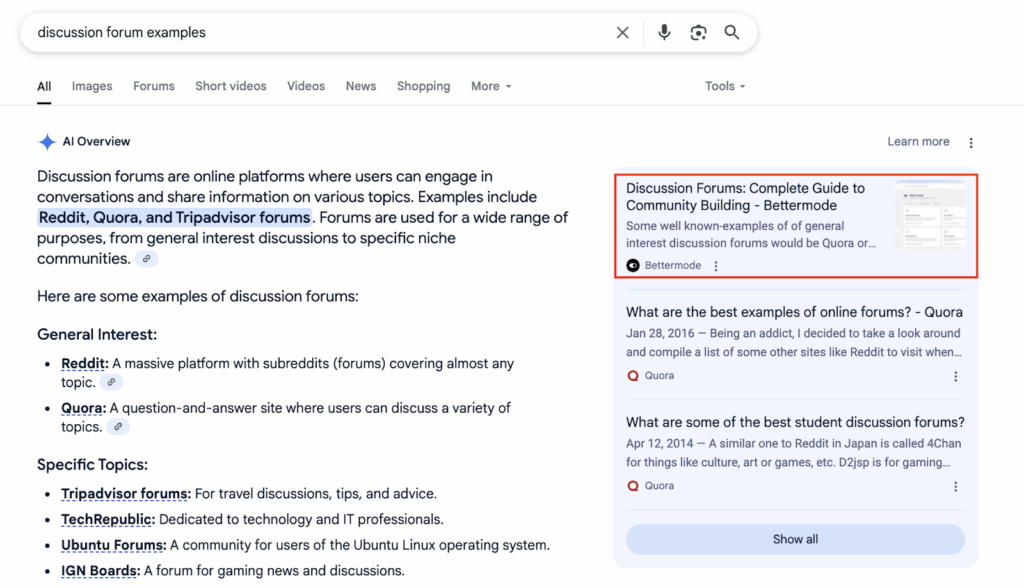Olga Mykhoparkina
Founder, CEO

Olga Mykhoparkina
Jul 11, 2025We all know search is changing. People don’t want to scroll through 2,000-word blog posts to find one quick answer – they want straight-up answers, right away. That’s exactly what AI assistants like ChatGPT, Perplexity, and even Google’s new AI Overviews are trying to deliver.
And it’s not just a hunch. A recent study found that 71.5% of Americans are already using AI tools like ChatGPT for searching, with 20% actually switching their primary search platform in the past year.
But just because the way people search is changing doesn’t mean your blog posts are useless. Far from it. You don’t need to scrap everything and start over – you just need to reformat the content you already have so it works better in this new answer-first online world.
Why does this shift matter for you, as a SaaS marketer? Because your buyers are searching differently. They’re asking AI assistants for product recommendations and solutions, often skipping traditional search results altogether. If your brand isn’t showing up in those AI-generated answers, you’re missing out on high-intent traffic and letting competitors own the conversation.
In this post, I’ll show you how to repurpose your existing content into formats AI tools actually use – so you can get your brand appear in ChatGPT and other LLM answers.
AI assistants are changing how people search for and consume information. Instead of scrolling through ten blog posts to find an answer, users now expect quick, conversational responses. Tools like ChatGPT and Perplexity pull information from across the open web, and they often pull from content you’ve already written.
But it’s not just third-party assistants. Google’s search results are evolving too. With AI Overviews now showing up for a wide range of queries, your content needs to be ready for a new kind of visibility where direct answers, not just links, get the spotlight.

.
Most blog posts are written for humans, not AI assistants. They’re not reading every paragraph and appreciating your clever analogies or smooth transitions. They’re scanning for facts, definitions, steps, stats – the useful bits.
So if your blog post opens with a vague intro, buries the point halfway down, and ends with a fluffy conclusion, chances are it’s getting skipped. Not because it’s bad, but because it’s not formatted in a way AI can easily pull from.
Most SaaS blogs are full of useful insights. You’ve probably already answered dozens of common questions in your space. It’s just trapped inside walls of text. Repurposing your blog content for AI assistants gives it a better chance of being surfaced in these new formats, both in Google and beyond.
It makes your existing content work smarter in a search world that’s shifting from links to answers.
So, if you want your brand to show up where people are actually looking for answers, it’s time to rethink how your blog content is packaged and delivered.
Dig deeper: SEO vs GEO: Why Your Content Might Be Invisible in AI Search (And How to Fix It)
So what kind of content actually gets picked up by AI assistants? The answer is simple – the kind that’s clear, direct, and helpful. Content that goes straight to the point.
If you want your content to show up in AI-generated answers, it needs to do one thing really well: answer real questions quickly. That means no unnecessary explanation and no long-winded intros. But helpful info, structured in a way that’s easy to find and easy to use.
Here’s what that looks like in practice:
In short: write like you’re trying to help someone, not like you’re trying to rank on Google. Ironically, that’s what makes your content more likely to show up in AI-powered results anyway.
Related: Structuring Web Pages for AI-First Indexing
You don’t need to start from scratch. If you’ve been blogging for a while, you probably already have a ton of useful content – it just needs a bit of reshaping to work better for AI assistants.
Here’s how to do it without turning it into a huge project:
Go through your blog and look for posts that answer real questions – the kind of questions people type into Google or ask on calls. Focus on evergreen topics – those that stay relevant over time. These are your best articles for repurposing.
Think: “How does [X] work?”, “What’s the difference between [A] and [B]?”, “Best practices for [Y],” etc.
A single 2,000-word blog post can often be turned into 10 or more high-quality snippets. Pull out each section that answers a specific question or explains a clear concept. Think of it like turning one deep-dive guide into a stack of helpful, bite-sized solutions.
These are the kinds of structures AI assistants love. They’re easy to scan and understand. Reformat sections of your blog into question-and-answer pairs, bullet lists, and straightforward definitions. This structure makes it easier for AI tools to pick out the exact info they need
If a blog includes a section like “5 steps to do X,” format it as a list. If you’re explaining a term, make the definition easy to grab. Don’t bury it halfway down the page.
Ditch the vague intros, fluffy conclusions, and anything that doesn’t directly answer the question. Keep your snippets focused and direct. If it doesn’t help the reader (or AI) get to the answer faster, cut it.
For each post, include a quick summary or a “key takeaways” section right at the top. This not only helps your human readers but also gives AI assistants a clear, concise answer to serve up.
Add schema markup – especially FAQ and HowTo schemas. You don’t need someone technical to do this. It can be done in wp plugging. This helps search engines and AI assistants understand the structure and intent of your content, making it more likely to be featured in answer boxes or AI responses.
Dig deeper: Schema & Structured Data for LLM Visibility: What Actually Helps?
Don’t let your content go stale. Regularly update your repurposed snippets with the latest data, stats, and examples. AI assistants prioritize up-to-date, accurate info – so keep your content fresh to stay visible
The goal isn’t to rewrite everything – just to shape what you already have into something AI tools can actually use. Think of it like taking a long-form article and turning it into a helpful cheat sheet. That’s how you get your brand in front of the right people, right when they need answers.
You might be interested in LLMs vs SEO: What’s Changing in Search Discovery
Let’s talk about real results. At Quoleady, we’ve helped SaaS brands not only rank on Google but also get featured in AI-powered answers – right where your future customers are looking.
With just a few smart tweaks, our clients are showing up in Google AI Overviews and even getting cited by large language models (LLMs) like ChatGPT in real-time responses.
Here’s what that looks like in action:
We optimized blog content for clarity, direct answers, and keyword intent – and both PassKit and Loopy Loyalty ended up featured as the top two answers in an LLM response for “loyalty card software.” Just clear explanations, structured headings, and questions people actually search for.

For ResponseScribe, we focused on simplifying their content and answering key questions head-on. That same blog post was later cited directly in a Google AI-generated summary – the kind that shows up before any organic results. It didn’t require a full rewrite, but better formatting and a more useful structure.

Read also: Top 6 Generative Engine Optimization (GEO) Agencies of 2025
For Fuel Finance, we went all-in on structure: adding FAQ schema, clear data tables, and question-style subheadings. We also broke down complex ideas into bite-sized, skimmable sections. Their post now ranks for “AI forecasting tools” in Google AI Overviews and gets cited by LLMs like ChatGPT for the same keyword. All because it answers questions directly and includes structured support.

These results are what happens when your blog content is formatted for answers, not just rankings. You don’t need to overhaul your strategy; you just need to make your expertise easy for AI to find and share. That’s what we do at Quoleady – helping your brand show up everywhere answers are happening.
If you’re thinking “Do I need to start writing a totally different kind of content?” – not really. Your blog is still one of the most valuable assets you have. You just need to treat it as more than an SEO play.
Here’s how to make it work for AI-driven discovery too:
Your blog is where your expertise lives. It is still your best tool for showing up in AI-powered search results. AI assistants and Google’s new AI Mode are scanning for clear, structured, and up-to-date answers. Treat your blog as the foundation, not just a side project.
Some of the best content ideas come straight from your product and support teams. They know the real questions users are asking–grab those and turn them into Q&A-style content or detailed how-tos.
Dig deeper: How Retrieval-Augmented Generation (RAG) Impacts AI Recommendations And What SaaS Marketers Should Do to Stay Ahead
You’re not writing a whitepaper. You’re talking to someone who wants a fast, clear answer. Keep it friendly, direct, and skip the jargon. The more your content sounds like something you’d say out loud, the better.
You don’t need to write more – just revisit what you already have. Add clear subheadings. Summarize key points. Strip out filler. Even small changes can make a post more AI-friendly and more useful to readers.
Most of this comes down to one mindset shift: stop thinking only in keywords and rankings. Start thinking in questions and answers. That’s where AI is heading – and your blog can lead the way.
You don’t need to scrap your entire content or reinvent your strategy. The foundation is already there – your expertise, your insights, and your published posts. What’s needed now is a shift in how that content is structured and surfaced.
AI tools and Google’s AI Overviews are prioritizing clear, concise, and well-organized answers. To appear in those results, your content should reflect that. Focus on clarity. Eliminate filler. Answer specific questions in a way that’s easy for both humans to understand and LLM tools to parse.
Repurposing your old content makes sure the value in your content can be found in the formats LLM tools actually use today.
Ready to work on the blog changes?? Book a call with Quoleady and we’ll show you the 20% of effort that drives 80% of your results.
LLM-friendly content is clear, structured, and easy for AI tools to understand and use in answers. It avoids fluff and gets straight to the point.
Blog posts that answer real questions like how-tos, comparisons, definitions, and FAQs. These are perfect for repurposing.
Break long posts into short Q&A-style sections, use clear headings, cut the filler, and format answers in a scannable way.
Use direct language, structured formats (like lists and FAQs), answer real questions clearly, and keep your content up to date.
Let us know what you are looking to accomplish.
We’ll give you a clear direction of how to get there.
All consultations are free 🔥
